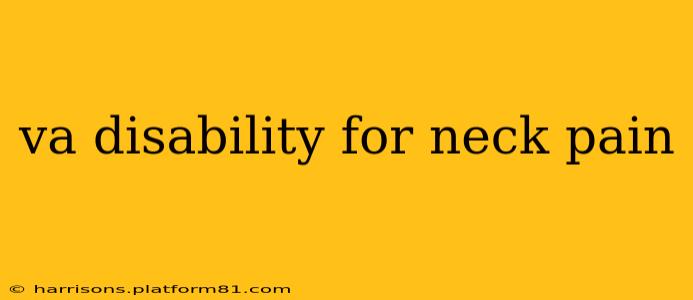Neck pain is a prevalent condition affecting millions, and veterans are no exception. Many veterans experience neck pain stemming from service-related injuries or conditions aggravated during their time in uniform. Understanding how to navigate the VA disability claim process for neck pain is crucial for receiving the benefits you deserve. This guide provides a comprehensive overview of the process, addressing common questions and concerns.
What Causes Neck Pain in Veterans?
Neck pain can stem from various sources, many directly linked to military service. Common causes include:
- Traumatic Injuries: Accidents, explosions, falls, and combat-related injuries can cause significant neck trauma leading to chronic pain, whiplash, herniated discs, or spinal cord injuries.
- Repetitive Strain Injuries: Prolonged periods of carrying heavy equipment, awkward postures (especially while operating machinery or driving), and repetitive movements can strain neck muscles and ligaments, eventually leading to chronic pain.
- Stress and Anxiety: The psychological toll of military service can manifest physically, often contributing to muscle tension and chronic neck pain.
- Exposure to Hazardous Materials: Exposure to toxins or other harmful substances may contribute to degenerative conditions affecting the neck.
- Arthritis: Osteoarthritis and other forms of arthritis can develop over time and cause significant neck pain. While not always directly service-connected, prior injuries may accelerate the onset or severity.
How to File a VA Disability Claim for Neck Pain
Filing a claim for VA disability benefits requires meticulous documentation and attention to detail. Here's a step-by-step overview:
- Gather Evidence: Collect all relevant medical records, including doctor's notes, diagnostic tests (X-rays, MRIs, CT scans), physical therapy records, and any documentation related to your neck pain. If possible, obtain statements from fellow service members who can attest to your injury or its aggravation during service.
- Complete VA Form 21-526EZ: This is the application form for disability benefits. Be thorough and accurate in completing all sections. Clearly describe your neck pain, its onset, and how it impacts your daily life.
- Submit Your Claim: Submit your completed form and supporting documentation to the VA. You can do this online, by mail, or in person at a VA regional office.
- Attend Examinations: The VA may schedule examinations to assess the severity of your neck pain and its connection to your military service. Be prepared to answer questions thoroughly and honestly.
- Follow Up: After submitting your claim, regularly follow up with the VA to check on the status of your application.
What is Considered a Service-Connected Disability?
A service-connected disability means your neck pain is directly related to your time in the military. The VA will review your evidence to determine if a nexus (connection) exists between your neck pain and your military service. This often involves establishing a clear link between a specific event or condition during your service and your current neck pain.
How is Neck Pain Rated by the VA?
The VA rates neck pain based on its severity and how it impacts your daily activities. The rating is expressed as a percentage from 0% to 100%, reflecting the level of disability. Higher percentages indicate greater impairment. The rating is determined through a combination of your medical records and a clinical examination.
What if My Claim is Denied?
If your initial claim is denied, you have the right to appeal. The appeals process can be complex, and it’s often beneficial to seek assistance from a veteran's service organization or a qualified attorney specializing in VA disability claims. They can help you gather additional evidence and navigate the appeals process effectively.
What Treatments are Available for VA-Rated Neck Pain?
The VA offers a range of treatment options for neck pain, including:
- Physical Therapy: Strengthening and stretching exercises to improve range of motion and reduce pain.
- Medication: Pain relievers, muscle relaxants, and anti-inflammatory drugs.
- Injections: Corticosteroid injections to reduce inflammation.
- Surgery: In severe cases, surgery may be necessary to correct underlying spinal issues.
This information is for general guidance only and should not be considered legal or medical advice. It is crucial to consult with a qualified medical professional and a veteran's service organization or attorney for personalized advice regarding your specific situation. The VA disability claims process can be intricate, and seeking professional help can significantly increase your chances of success.
